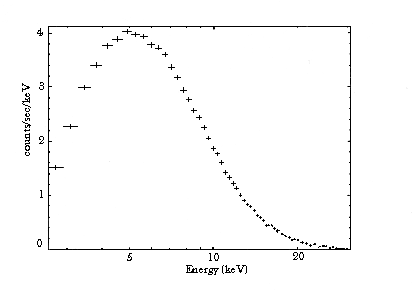Shedding a New Light on the Universe
Spectroscopy
Spectroscopy is simply the science of measuring and graphing the intensity of light at different energies. X-ray light contains a range of energies just like visible light, with its range from reds to blues. Satellites like the Rossi X-ray Timing Explorer (RXTE) have spectrometers on them. RXTE's spectrometer counts the number of photons of differing energies hitting it. A graph of the number of photons over an energy range can tell us how the source is producing its X-rays, and give us clues as to what kind of object it is! Spectra of stars can give us information about their composition, since particular elements emit light at characteristic energies evident as peaks in the spectrum. Spectra of black holes can reveal orbiting disks of matter.
Here is an example of a spectrum:

This spectrum is from an X-ray pulsar - that is to say a very swiftly rotating neutron star that gives off pulses of X-rays. Neutron stars are the dense remnants left at the core of massive stellar explosions. This plot shows the number of photons within small energy intervals that are emitted per second, plotted over a range of energies. Most of the photons being emitted by this source have an energy near 5 keV. This pulsar does emit photons at energies lower and higher than 5 keV, but not with as great a likelihood. Comparitively few photons are being produced with energies near 20 keV.

Previous |

Next |


